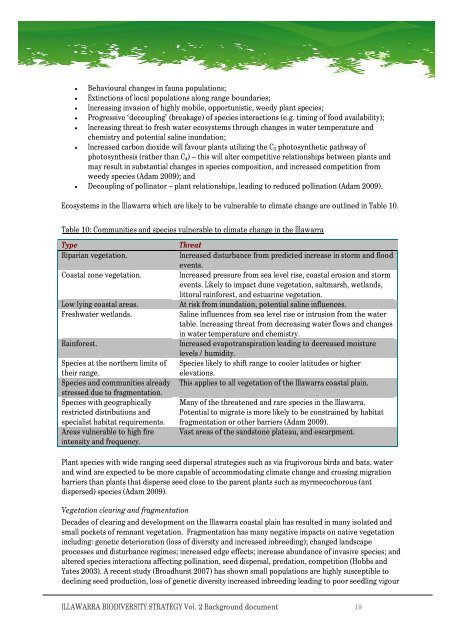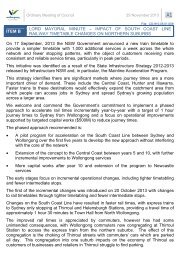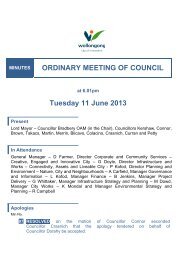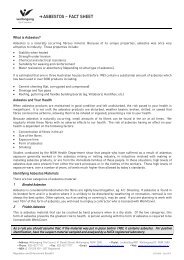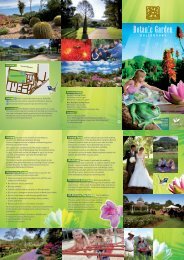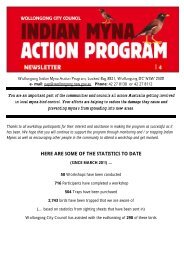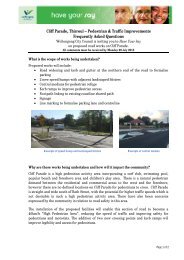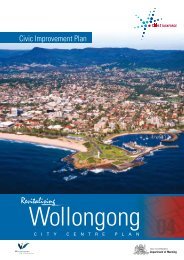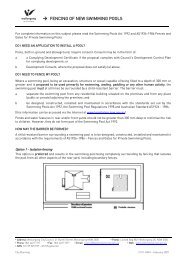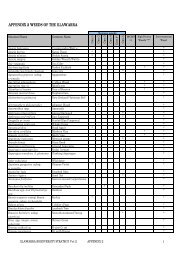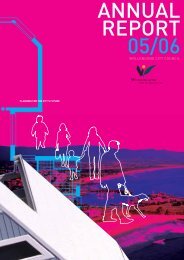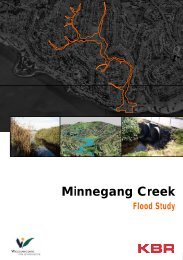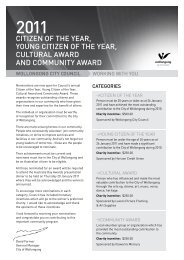ILLAWARRA BIODIVERSITY STRATEGY Vol. 2 - Wollongong City ...
ILLAWARRA BIODIVERSITY STRATEGY Vol. 2 - Wollongong City ...
ILLAWARRA BIODIVERSITY STRATEGY Vol. 2 - Wollongong City ...
- No tags were found...
Create successful ePaper yourself
Turn your PDF publications into a flip-book with our unique Google optimized e-Paper software.
• Behavioural changesinfauna populations;• Extinctionsof local populationsalong range boundaries;• Increasing invasionof highlymobile, opportunistic,weedy plant species;• Progressive ‘decoupling’ (breakage)ofspeciesinteractions (e.g. timing offoodavailability);• Increasing threatto freshwater ecosystemsthroughchanges in watertemperature andchemistry and potentialsaline inundation;• Increasedcarbondioxide willfavour plants utilizing the C 3 photosyntheticpathwayofphotosynthesis (rather than C 4 ) – thiswill alter competitiverelationships between plants andmayresultin substantialchanges in species composition, andincreasedcompetition fromweedy species (Adam2009); and• Decoupling of pollinator – plant relationships, leading toreducedpollination(Adam2009).Ecosystems in the Illawarra whicharelikely to be vulnerable to climate change are outlinedin Table10.Table 10:Communitiesandspeciesvulnerable to climate changein the IllawarraTypeRiparian vegetation.Coastalzone vegetation.Low lying coastal areas.Freshwater wetlands.Rainforest.Speciesat thenorthernlimits oftheir range.Speciesandcommunities alreadystresseddue to fragmentation.Specieswithgeographicallyrestricteddistributions andspecialist habitat requirements.Areas vulnerable to high fireintensity andfrequency.ThreatIncreased disturbance from predicted increase instorm andfloodevents.Increased pressure from sealevel rise, coastal erosionand stormevents. Likely to impact dune vegetation, saltmarsh, wetlands,littoralrainforest, andestuarine vegetation.At risk from inundation,potentialsalineinfluences.Saline influences from sea levelriseor intrusionfrom the watertable.Increasingthreat from decreasingwaterflowsandchangesin water temperature andchemistry.Increasedevapotranspirationleading to decreasedmoisturelevels/humidity.Species likely toshift range to coolerlatitudes orhigherelevations.This applies to allvegetationof the Illawarracoastalplain.Manyofthe threatenedandrare species inthe Illawarra.Potentialto migrate ismore likely to beconstrainedby habitatfragmentationorother barriers (Adam2009).Vastareas of thesandstone plateau,and escarpment.Plant specieswithwide ranging seed dispersalstrategies suchasviafrugivorous birds and bats,waterand wind areexpected to be more capableofaccommodating climatechange and crossingmigrationbarriers than plants that disperse seedclose to the parent plants suchasmyrmecochorous(antdispersed) species(Adam 2009).Vegetationclearing andfragmentationDecadesof clearing anddevelopmenton the Illawarracoastal plain has resulted inmanyisolatedandsmallpocketsof remnant vegetation. Fragmentationhas many negative impactsonnative vegetationincluding: genetic deterioration (lossof diversity andincreasedinbreeding); changedlandscapeprocesses anddisturbanceregimes; increasededgeeffects; increase abundanceof invasive species;andalteredspeciesinteractionsaffecting pollination, seeddispersal, predation,competition(HobbsandYates2003).Arecentstudy (Broadhurst2007) hasshownsmallpopulations are highly susceptible todecliningseedproduction,lossof genetic diversity increasedinbreeding leading to poorseedlingvigour<strong>ILLAWARRA</strong> <strong>BIODIVERSITY</strong><strong>STRATEGY</strong><strong>Vol</strong>.2Background document 19


